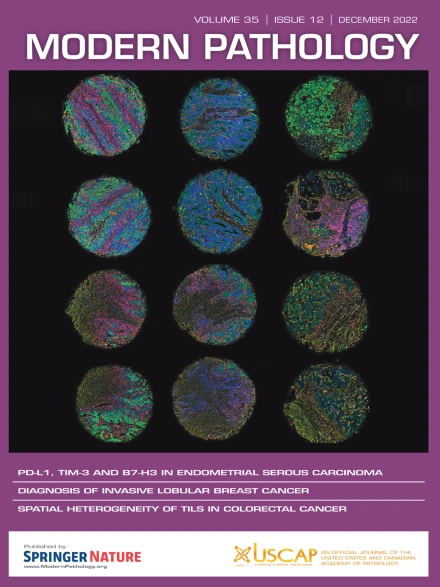胶质母细胞瘤患者预后分层的多模式可解释人工智能。
IF 5.5
1区 医学
Q1 PATHOLOGY
引用次数: 0
摘要
胶质母细胞瘤是成人中枢神经系统最常见和侵袭性的恶性肿瘤,预后恶劣,形态学和分子特征不均匀。自2005年采用目前的标准治疗以来,没有发现显著的预后改善。在这项研究中,我们寻求从常规获得的苏木精和伊红染色的全切片图像(WSI)和临床数据中识别与预后相关的胶质母细胞瘤特征,通过先进的计算方法进行整合,可以改善患者的预后分层,从而优化临床决策和患者管理。所提出的WSI分析利用了明显人工内容的综合管理和可解释性机制,通过弱监督的基于注意力的多实例学习方法,进一步利用聚类来限制搜索空间。我们的方法自动识别出具有高预后价值的模式,将每个WSI分类为短期或长期幸存者的代表。使用XGBoost和shapley加性解释(SHAP),对相关临床患者数据的预后相关性进行单独和综合评估。与使用任何一种模式相比,WSI与临床数据的多模式整合可提高分层性能。确定与短期和长期生存相关的肿瘤形态和临床模式将使临床神经病理学家能够为治疗团队提供额外的相关预后信息,并为进一步了解和潜在治疗胶质母细胞瘤提供生物学研究途径。本文章由计算机程序翻译,如有差异,请以英文原文为准。
Multimodal Explainable Artificial Intelligence for Prognostic Stratification of Patients With Glioblastoma
Glioblastoma (GBM) is the most common and aggressive malignant adult tumor of the central nervous system, with a grim prognosis and heterogeneous morphologic and molecular profiles. Since the adoption of the current standard-of-care treatment in 2005, no substantial prognostic improvement has been noticed. In this study, we seek the identification of prognostically relevant GBM characteristics from routinely acquired hematoxylin and eosin–stained whole slide images (WSIs) and clinical data, which when integrated via advanced computational methods could yield improved patient prognostic stratification and hence optimize clinical decision making and patient management. The proposed WSI analysis capitalizes on a comprehensive curation of apparent artifactual content and an interpretability mechanism via a weakly supervised attention-based multiple-instance learning approach that further utilizes clustering to constrain the search space. Patterns automatically identified by our approach as of high prognostic value classify each WSI as representative of short or long survivors. Further assessments of the prognostic relevance of the associated clinical patient data are performed both in isolation and in an integrated manner, using XGBoost and SHapley Additive exPlanations. The multimodal integration of WSI with clinical data yields enhanced stratification performance when compared with using either one of the modalities. Identifying tumor morphologic and clinical patterns associated with short and long survival will enable the clinical neuropathologist to provide additional relevant prognostic information to the treating team and suggest avenues of biological investigation for further understanding and potentially treating GBM.
求助全文
通过发布文献求助,成功后即可免费获取论文全文。
去求助
来源期刊

Modern Pathology
医学-病理学
CiteScore
14.30
自引率
2.70%
发文量
174
审稿时长
18 days
期刊介绍:
Modern Pathology, an international journal under the ownership of The United States & Canadian Academy of Pathology (USCAP), serves as an authoritative platform for publishing top-tier clinical and translational research studies in pathology.
Original manuscripts are the primary focus of Modern Pathology, complemented by impactful editorials, reviews, and practice guidelines covering all facets of precision diagnostics in human pathology. The journal's scope includes advancements in molecular diagnostics and genomic classifications of diseases, breakthroughs in immune-oncology, computational science, applied bioinformatics, and digital pathology.
 求助内容:
求助内容: 应助结果提醒方式:
应助结果提醒方式:


